The general as well as judicial administrations of the Ryūkyū kingdom were conducted on the basis of local autonomy by local government agencies. The central government level only took up responsibility when all else failed. This constitutes the framework for further inquiries into security-related functions and duties within the royal government, which you find described completely in my Karate 1.0 only.
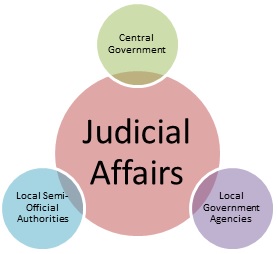
Division of judicial affairs.
Within the royal government organization there was the Board of General Affairs (mōshiguchi-hō), which was created following the 1609 Satsuma hostile takeover. The four departments and their sub-agencies arranged under this board, however, were already in existence previously. Their functions in many respects corresponded to the function of law, police and security.
The most important department in connection with law enforcement and inner stability on the central government level was the Department of Justice.
The Department of Justice (Hirajo)
The Department of Justice acted as the central government office managing all judicial affairs of the kingdom. It was direced by a Superintendent (hira no soba) and an Assistant Superintendent (hira ginmiyaku) as representatives of the central government.
Originally, the department was involved in preliminary investigations and actual execution of penalties inflicted upon criminals. Historically, according to the Kyūyō, the Department of Justice had been in existence since olden times when it was used for interrogations. Shuri’s three administrative districts (Shuri mihira) were administered by chief judges (ufuyaku) and clerks (hissha), alternating in the management of legal disputes and civil suits of Shuri’s three districts.
Coming the early modern times the department began to also handle the affairs of the various Anji as well as affairs related to criminals. In 1786 the first “Ryūkyū Penal Code” (Ryūkyū Karitsu) and the “Regulations for Court Trials” (Kyūmei Hōjō) were promulgated. At the same time a second guard house for the jail was built. By this time the Department of Justice had become the full-fledged supreme court of the kingdom.

The upper stratum of the Ryūkyū government organization during the era of Shimazu control
Criminal as well as civil trials were conducted by senior chief judge (ōyako-nushidori) and chief judges (ōyako). Penalties included payment of fines, confinement to a temple, tattooing, beating with whips, imprisonment, and exile to remote islands.
The Department of Justice and its official building concurrently served as courthouse, a police station, and the main penitentiary. Consequently, its very nature called for appropriate executive authority, personnel and facilities. The operative and administrative law enforcement was carried out by a number of official duties.
This included the Ufuchiku (see also here) of the department of justice (hirajo ufuchiku). This post is comparable to a police lieutenant (keibuho). They were the highest officials on operational level related to all kinds of guard, patrol, or escort duties as well as interrogations, and they had investigative authority.
Next there were the Wakichiku, who can be likened to bodyguards and escort guards (keigo). Then, there were the Chikusaji, who were similar to regular policemen (junsa).
And finally there were the Fūchiku as the lowest echelon within the Department of Justice. Furthermore, the different kinds of ~chiku would frequently accompany judges sent out to the rural areas.
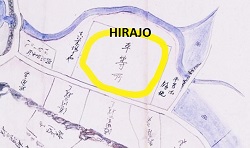
The Department of Justice (Hirajo) of the Royal Government of Ryūkyū was located in Kubagawa at the northern outskirts of Shuri’s Nishi-no-Hira district. Nishi-no-hira (the western district) consisted of the villages Gibo, Akabira, Teshiraji, and Kubagawa. It was a area filled with government buildings such as the Kikoe Ōkgimi Udun and the Hirajo as well as an upper class residential area for Ōji (princes), Anji and Uēkata families.
The direct operational responsibilities of the Department of Justice also included the guarding of the royal family tombs and royal mausoleum (Tamaudun) as well as other places closely related to the royal family. Naturally, in the ideology of the kingdom all things royal were considered sacrosanct. Accordingly, when criminals damaged the royal mausoleum and other holy places in Shuri around 1734, this was considered a serious criminal case and the perpetrators were tried by the Department of Justice. Subsequently permanent guards were put on official duty at all facilities associated with the royal family. Some of these guards continued to exist even after the abolition of the kingdom, as can be seen in an eye-witness account written by the journalist Yokoyama Kendō (1872-1943).
The system worked so well that in the 12th month of 1871 it was reported that the prison (reigo) was empty. A large number of Ōji, Anji, Sanshikan, Uēkata, and leading officials of the country proceeded to the Royal Study in Shuri Castle to offer congratulations for the matter. All members of the Department of Justice, from the Superintendent down to the office clerks, were presented with awards.
Well, according to the extant sources, I was able to reconstruct the court building of the Department of Justice of the Royal Government of Ryūkyū, which you can see in the following graphic:
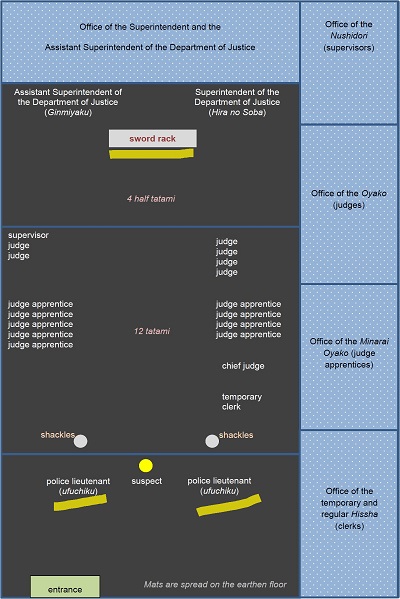
Diagram of the Department of Justice (Hirajo) of the Royal Government of Ryūkyū used as a court house. It was located in Kubagawa at the northern outskirts of Shuri’s Nishi-no-Hira district.
On the bottom you see the entrance. The first part of the building was where the perpetrator was positioned and there were shackles to tie him. On both sides of him was the place of the Ufuchiku, of which there were two.
In the next part of the room where positioned the various judges and clerks, and in the rear part of the room were the places of the Superintendent and the Assistant Superintendent of the Department of Justice, right in front of whom is found sword rack.

Old Sai of a peculiar kind.
Well, when in Okinawa in 2009, after the formal cup of tea and chit-chat (you really want to follow this procedure!), my friend rummaged around in his store and came up with two iron things he said were old sai, like we use in saijutsu. As you can see in the photo to the right, they were a bit different than the usual sai though. I could throw in a hundred pics of sai but thought these are quite interesting.
As regards the Ufuchiku, the suspect, and the shackles shown in the diagram of the Department of Justice during trials, I thought about the use of the sai as follows:
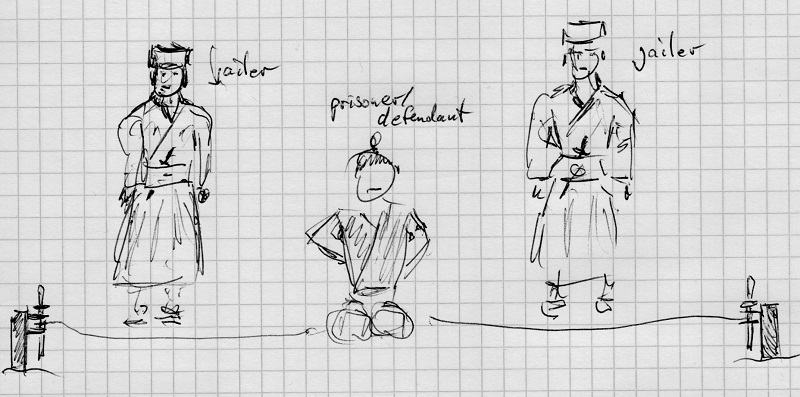
Possible use of Sai in combination with the shackles. In this way tied to two sides. it would indeed by difficult for the suspect to try any nonsense.
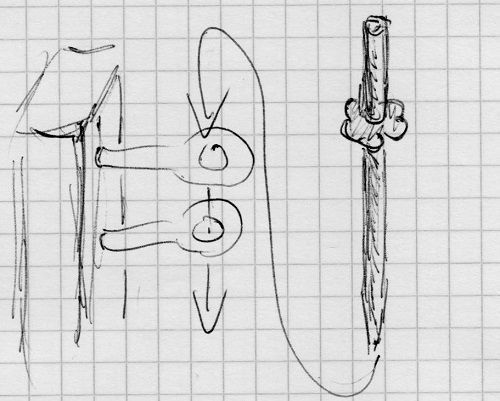
Detail.
© 2015 – 2022, Andreas Quast. All rights reserved.
